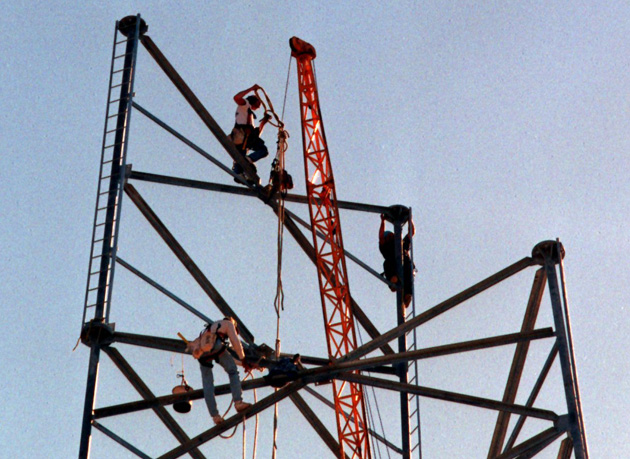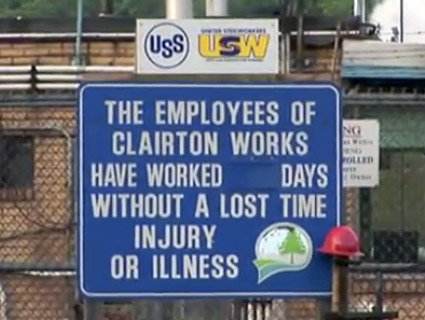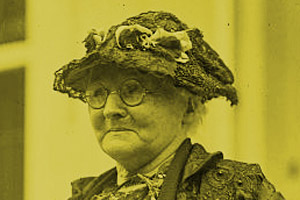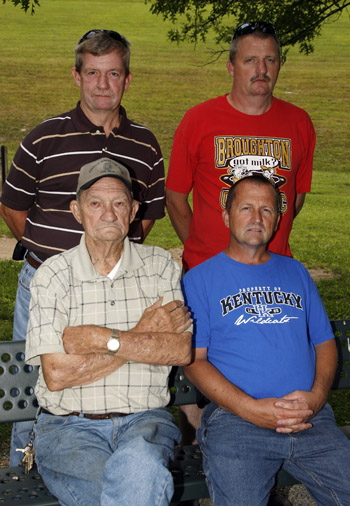 Retired Kentucky coal miner Ray Marcum (bottom left) and his sons (clockwise from top left) Thomas, James, and Donald. All four have a form of black lung. Photo by Center for Public IntegrityRay Marcum bears the marks of a bygone era of coal mining. At 83, his voice is raspy, his eastern Kentucky accent thick and his forearms leathery. A black pouch of Stoker’s 24C chewing tobacco pokes out of the back pocket of his jeans. “I started chewing in the mines to keep the coal dust out of my mouth,” he says.
Retired Kentucky coal miner Ray Marcum (bottom left) and his sons (clockwise from top left) Thomas, James, and Donald. All four have a form of black lung. Photo by Center for Public IntegrityRay Marcum bears the marks of a bygone era of coal mining. At 83, his voice is raspy, his eastern Kentucky accent thick and his forearms leathery. A black pouch of Stoker’s 24C chewing tobacco pokes out of the back pocket of his jeans. “I started chewing in the mines to keep the coal dust out of my mouth,” he says.
Plenty of that dust still found its way to his lungs. For the past 30 years, he’s gotten a monthly check to compensate him for the disease that steals his breath—the old bane of miners known as black lung.
In mid-century, when Marcum worked, dust filled the mines, largely uncontrolled. Almost half of miners who worked at least 25 years contracted the disease. Amid strikes throughout the West Virginia coalfields, Congress made a promise in 1969: Mining companies would have to keep dust levels down, and black lung would be virtually eradicated.
Marcum doesn’t have to look far to see that hasn’t happened. There’s his middle son, Donald, who skipped his senior year of high school to enter the mines here near the West Virginia border. At 51, he’s had eight pieces of his lungs removed, and he sometimes has trouble making it through a prayer when he’s filling in as a preacher at Solid Rock Baptist Church.
There’s James, the youngest, who passed on college to enter the mines. At 50, his ability to breathe is rapidly declining, and his doctor has already discussed hooking him up to an oxygen tank part-time.
Both began working in the late 1970s—years after dust rules took effect—and both began having symptoms in their 30s. Donald now has the most severe, fastest-progressing form of the disease, known as complicated coal workers’ pneumoconiosis. James and the oldest Marcum son, Thomas, 59, have a simpler form, but James has reached the worst stage and is deteriorating.
Men with lungs like the Marcums’ are not supposed to exist. In the hard-won 1969 law, Congress demanded that dust be controlled and new cases of disease be prevented. The idea was that even if black lung didn’t disappear there would be a small number of mild cases and virtually no one like Donald and James Marcum, said Dr. Donald Rasmussen, a pioneer in recognizing and diagnosing black lung.
“In 1969, I publicly proclaimed that the disease would go away before we learned more about it,” Rasmussen, now 84 and still diagnosing miners, said in a recent interview at his office in Beckley, West Virgina. “I was dead wrong.”
Throughout the coalfields of Appalachia, in small community clinics and in government labs, it has become clear: Black lung is back.
The disease’s resurgence represents a failure to deliver on a 40-year-old pledge to miners in which few are blameless, an investigation by the Center for Public Integrity and NPR has found. The system for monitoring dust levels is tailor-made for cheating, and mining companies haven’t been shy about doing so. Meanwhile, regulators often have neglected to enforce even these porous rules. Again and again, attempts at reform have failed.
A Center analysis of databases maintained by the federal Mine Safety and Health Administration found that miners have been breathing too much dust for years, but MSHA has issued relatively few violations and routinely allowed companies extra time to fix problems.
MSHA chief Joe Main issued a statement in response to the findings: “The current rules have been in effect for decades, do not adequately protect miners from disease and are in need of reform. That is why MSHA has proposed several changes to overhaul the current standards and reduce miners’ exposure to unhealthy dust.” Similar attempts at reform have died twice before.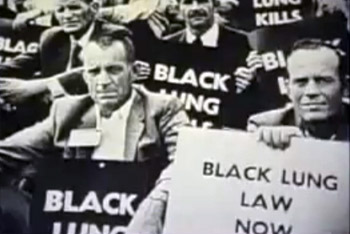 Coal miners striking for black-lung prevention, 1969 Photo by NIOSH
Coal miners striking for black-lung prevention, 1969 Photo by NIOSH
From 1968 through 2007, black lung caused or contributed to roughly 75,000 deaths in the United States, according to government data. In the decades following passage of the 1969 law, rates of the disease dropped significantly. Then, in the late 1990s, this trend reversed.
Many of the newer cases have taken a particularly ugly form. While rates of black lung overall have increased, incidence of the most severe, fast-progressing type has jumped significantly. These cases, moreover, are occurring in younger and younger miners. Of particular concern are “hot spots” identified in central Appalachia by the National Institute for Occupational Safety and Health (NIOSH), a government research agency. Though levels are still below what they were before 1970, medical experts and miners’ advocates are alarmed.
“I think any reasonable epidemiologist would have to consider this an epidemic,” said Scott Laney, a NIOSH epidemiologist. “All cases of [black lung] are preventable in this day and age, but these cases of [the most severe form] are just astounding…This is a rare disease that should not be occurring.”
The National Mining Association, the main trade group representing mining companies, disputes some of NIOSH’s data but agrees that black lung’s resurgence is a problem in need of attention. To the association, however, it is primarily a regional phenomenon of central Appalachia—one that doesn’t justify new national rules. What’s needed, the group says, is further study and better enforcement of current standards.
Researchers are struggling to explain what, after years of progress, has caused the backsliding and why black lung, traditionally viewed as an old man’s disease, is striking younger and younger miners and robbing them of their breath faster and faster. They are trying to figure out why men like the Marcums are the new face of black lung.
“A diabolical torture”
“They call me Lucky,” retired miner James Foster says as he takes off his shirt and presses his chest against an X-ray machine in the back of an RV in Wharton, West Virginia. “Worked 37 years in all kinds of mines. Been covered up twice. Been electrocuted.”
His brushes with death aside, he’s here because he fears there may be one hazard he can’t dodge. “I come in here to file for my black lung,” he says. During a recent heart surgery, he says, doctors said they saw what appeared to be signs of the disease.
He’s one of a handful of miners on an April afternoon to move through the RV parked at the fire department in Wharton, in the heart of coal country. Inside, a team of NIOSH workers shepherds them from station to station: medical history, questionnaire, breathing test, chest X-ray. Foster hopes the tests will provide evidence he can use to submit a claim for benefits. Other miners are still working and want to make sure their lungs are clear.
It is from this rolling medical unit, in part, that NIOSH has documented the return of black lung. For decades, miners have been entitled to free X-rays every five years, and this has helped track the drop in the disease’s prevalence. After the data started showing a reversal, NIOSH sent its RV out to gather more data in 2005.
What these researchers found, combined with data from routine medical monitoring, was worrisome: From the 1970s through the 1990s, the proportion of miners with signs of black lung among those who submitted X-rays dropped from 6.5 percent to 2.1 percent. During the most recent decade, however, it jumped to 3.2 percent.
Even more disturbing: Prevalence of the most severe form of the disease tripled between the 1980s and the 2000s and has almost reached the levels of the 1970s.
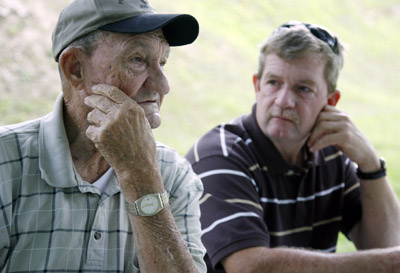 Ray Marcum (left) and his son Thomas Photo by Center for Public Integrity
Ray Marcum (left) and his son Thomas Photo by Center for Public Integrity
In a triangle of Appalachia—southern West Virginia, eastern Kentucky and western Virginia—the numbers were even higher. The rolling unit found a disease prevalence of 9 percent in Kentucky from 2005 to 2009, for example.
A wake-up call for some came after the Upper Big Branch explosion in southern West Virginia in April 2010, which killed 29 miners. Of the 24 who had enough lung tissue for an autopsy, 17 had signs of black lung. Some had fewer than 10 years of experience in mines; they ranged in age from 25 to 61.
The disease leaves miners’ lungs scarred, shriveled, and black. They struggle to do routine tasks and are eventually forced to choose between eating and breathing.
“No human being should have to go through the misery that dying of [black lung] entails,” said Dr. Edward Petsonk, who treats patients with black lung and works with NIOSH. “It is like a screw being slowly tightened across your throat. Day and night towards the end, the miner struggles to get enough oxygen. It is really almost a diabolical torture.”
Underpinnings of an epidemic
There are theories about why the disease has returned, but no definitive answers. One likely explanation: Miners are breathing a more potent mix of dust. Coal seams are surrounded by rock, much of which contains the mineral silica. When ground up, silica is more toxic to the lungs than coal dust and can cause faster-progressing disease.
With larger coal seams becoming mined out, companies are turning to thinner seams surrounded by more rock. At the same time, because of the price of coal and advances in mining equipment, it now makes more sense economically for companies to cut through large amounts of rock to get at the coal. Companies haul it all out and then separate the rock from the coal at processing plants.
“In central Appalachia, you look at what’s coming out of the mines, and it’s probably 60 percent rock on a good day,” said Rick Honaker, a University of Kentucky professor who consults for mining companies and has seen their data.
NIOSH research suggests this may be having an effect. A particular marker on a chest X-ray is often indicative of silica-related disease. Comparing miners’ X-rays taken from 2000 to 2008 with those taken during the 1980s, researchers found that the proportion bearing these markers had nearly quadrupled and, in central Appalachia, had increased almost eight times over.
Rules are supposed to limit the amount of silica in the air in mines, but a CPI analysis of MSHA’s dust sampling database, obtained under the Freedom of Information Act, shows that the agency has long failed to control silica dust.
In each of the past 25 years, the average of all silica samples—taking into account only those deemed valid by MSHA—has been higher than the allowed limit. Last year, for example, roughly 40 percent of the valid samples were above this limit. What’s more, the limit MSHA enforces is already twice the level NIOSH determined to be safe (PDF) in 1974.
The National Mining Association contends that what appears to be a nationwide increase in black lung is actually a spike in silica-related disease in Appalachia. “The problem here is, look, these people were overexposed to horrendous levels of silica, for God’s sake,” said Bob Glenn, an expert hired by the association. “Why hasn’t something been done?”
To the association, this means there is no need for a new rule on coal dust, just better enforcement of the silica standard.
Another possible explanation for the uptick in disease: The number of hours worked by miners has steadily increased over the past three decades, MSHA data show. Ten- and twelve-hour shifts and six- or seven-day workweeks are now common.
“I have stayed [in a mine] sometimes two days and never come out,” said Donald Marcum. Sometimes, he said, “you’d just lay down beside the power box, sleep an hour or two, and stay right there.”
Longer hours mean more exposure to dust and less recovery time. The lungs can clear some dust by themselves if given the chance to recover, and many miners said in interviews that they often spit up a mixture of mucus and dust.
At the same time, production has increased, thanks in part to powerful new equipment. A longwall shearer, for example, can carve out huge swaths of coal in little time.
Mark McCowan ran one of these behemoths for the final years of his career. “By the time I was 40 years old, I had mined more coal than most miners mine in a lifetime,” he recalled, sitting in his living room in Pounding Mill, Virginia. “You would get in some areas of the coal face where, when you mine, you can’t see the hand in front of your face…I would eat so much dust I would throw up.”
McCowan was diagnosed with black lung at age 40. His disease has progressed to the most severe form; now 47, he finds it harder and harder to breathe. He pointed to a photo of a beaming, blond-haired 2-year-old on his wall—his grandson, Haiden. McCowan sees him two or three times a week and plays with him for as long as his lungs can take. “My biggest fear,” he said, “is I won’t live long enough for him to remember me.”
Decades of cheating
Donald Marcum knew he was at least a passive participant in something that was against the rules, maybe even criminal. Every couple of months, his bosses had to send MSHA five samples showing they were keeping dust levels under control. The man with the greatest potential exposure—often Donald because he was running a continuous mining machine, which chews through coal and rock and generates clouds of dust—was supposed to wear a pump to collect dust for eight hours.
That almost never happened. Most of the time, he said, the mine foreman or someone else would take the pump and hang it in the cleaner air near the mine’s entrance.
When MSHA inspectors showed up to take their own samples, it wasn’t so easy to cheat. Donald would actually wear the pump, but he and his coworkers would mine only about half as much coal as they normally did, generating far less dust.
“We just done what we was told because we needed to feed our families and really didn’t look at what it might be doing to our health,” he said.
Donald’s experience echoed what CPI and NPR reporters heard from retired miners throughout West Virginia, Kentucky, and Virginia who had worked underground as recently as 2008. Dust pumps ended up in lunchboxes or mine offices. Mine officials stalled regulators who had shown up for a surprise inspection and radioed to the men underground, who fixed the ventilation and cleaned up the work site.
It’s difficult to tell how widespread such practices are, but many former miners described some variation of cheating occurring regularly at almost every mine where they had worked—and a culture of fear fostered by the companies. “We always set and thought, you know, maybe if we didn’t do it this way, that they’d come in and shut the mines down. Then we’d be out of work,” said David Neil, a 52-year-old West Virginia miner with black lung who now drives a coal-hauling truck.
Tim Bailey, a lawyer in Charleston, West Virginia, zeroes in on this type of cheating when he sues a coal company on behalf of a miner with black lung. In general, the only option for miners who get the disease is to file a claim with the state or the US Department of Labor to try to get benefits. But Bailey takes a different tack, drawing on a state law that allows workers to sue their employer in cases of knowing exposure to dangerous conditions.
This often amounts to proving that the company manipulated its dust samples. In depositions, miners have described hanging dust pumps in cleaner air or getting advance warnings of inspections. Over the past eight years, he’s handled about 40 such cases. In each case, he said, the coal company eventually settled.
“These are criminal acts,” Bailey said. “What’s different about these black-lung cases is that the cheating is such a part of everyday practices.”
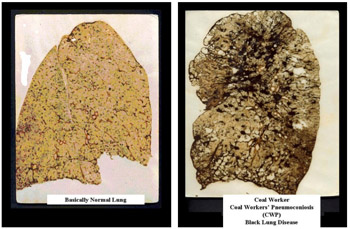 Black lung leaves miners’ lungs scarred, shriveled, and black (right) NIOSH
Black lung leaves miners’ lungs scarred, shriveled, and black (right) NIOSH
Then there are the numbers themselves. For decades, the average sample submitted by a coal company has been far below the limit. NIOSH researchers used a formula to estimate the prevalence of black lung that would be expected based on the dust samples and compared this with the disease rates actually occurring.
What the researchers found was surprising: The two didn’t match up at all. In some areas of the country, there was actually less black lung than they’d predicted. But in central Appalachia, the disease rates were much higher—more than three times the predicted levels in eastern Kentucky, for example. It was possible, researchers concluded, that the nature of the dust had become more potent. The other possibility: The dust samples reflected the results of rampant cheating.
Many of the games described by miners today remain unchanged from those outlined by miners who testified at a 1978 MSHA hearing. The early 1990s saw the “abnormal white center” scandal, in which MSHA figured out that many coal companies had blown dust off the sampling filters, leaving a white center, before submitting them. This led to a spate of criminal convictions of companies and some employees and contractors. These composed the bulk of the 185 guilty pleas or convictions for dust sampling fraud between 1980 and 2002, according to data provided by MSHA to CPI and NPR.
The agency refused to provide more recent data and wouldn’t say whether any criminal cases had been pursued since then. MSHA did provide data indicating that it had decertified 14 mine officials since 2009, pulling their authority to conduct dust samples.
“I don’t know if any [cheating] is going on today,” said Bruce Watzman, the National Mining Association’s senior vice president for regulatory affairs. “I hope not. We encourage our members to fulfill their obligations under the law.”
Cheating aside, the system for monitoring dust levels is almost designed not to detect problems. Nor has MSHA always been swift to act when violations do surface.
From 2000 to 2011, MSHA received more than 53,000 valid samples—both from companies and its own inspectors—that showed an underground miner had been exposed to more dust than was allowed, yet the agency issued just under 2,400 violations, a Center analysis of MSHA data showed.
This may be attributable, in part, to the way the rules are written. When companies submit five samples to MSHA, some are allowed to be above the limit. Only the average of these five has to be low enough, allowing companies to negate high samples taken from miners enshrouded in dust. What’s more, the pump runs for only 8 hours, even if the miner works 10 or 12.
While an inspector is sampling, a company is allowed to mine as little as half the amount of coal it normally does. Companies that typically cared little about hanging curtains to keep air flowing through the mine or making sure water sprays used to suppress dust were working suddenly did when it came time to sample, several miners said.
Even when a company gets caught with samples that are too high, all it has to do to make the citation go away is take five of its own samples that indicate compliance. “The analogy I use is, if I pull you over for speeding, going 80 in a 50,” Bailey said, “and I tell you…here’s a journal, and I want you to record your speed on this same piece of road for the next five days. And, if at the end of those five days, your speed is below the speed limit, then I am going to tear your ticket up.”
Sometimes MSHA has allowed dust citations to go uncorrected for weeks or even months, potentially leaving miners overexposed, a CPI analysis of agency data shows. MSHA sets a date by which a violation must be fixed, but, from 2000 to 2011, the agency granted extensions for 57 percent of the violations.
Long extensions have been particularly common in southern West Virginia, one of the key “hot spots” of disease resurgence identified by NIOSH. In this area, which accounted for about 30 percent of the nation’s dust sampling violations, MSHA gave companies an extension about two-thirds of the time and allowed, on average, about 58 extra days to prove compliance.
Asked about these numbers, the agency said in a statement, “The majority of these extensions…are for good reasons such as getting approved dust controls implemented or allowing the operator time to collect additional samples to submit to MSHA.”
A roadmap for reform
Even before the reappearance of black lung, the need for change was apparent. A proposed MSHA rule led to hearings in 1978, during which miners testified to widespread manipulation of dust samples. That proposal stalled and was withdrawn by the Reagan administration.
In 1995, NIOSH reviewed the scientific evidence and concluded that the limits for both coal dust and silica should be cut in half and periodic medical exams for miners should be enhanced. The same year, the secretary of labor appointed a committee to determine how to eliminate black lung.
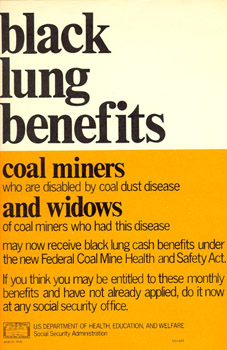 In 1969, President Nixon signed the first law designed to prevent black lung. Social Security Administration
In 1969, President Nixon signed the first law designed to prevent black lung. Social Security Administration
The committee’s report offered a roadmap for reform. It recommended that MSHA consider lowering the coal mine dust standard. It suggested the agency reduce miners’ silica exposure and establish a separate limit for this more potent type of dust. Samples should be taken while the mine was producing at least 90 percent of what it normally did, the panel said, and samples should be adjusted to reflect longer work shifts.
Perhaps its strongest recommendation: “The committee believes that the credibility of the current system of mine operator sampling to monitor compliance with exposure limits has been severely compromised…One of MSHA’s highest priorities should be to take full responsibility for all compliance sampling.”
In July 2000, MSHA proposed a rule that would have adopted some of these recommendations. Before the rule became final, though, George W. Bush took office, and the rule died.
“It’s really fairly remarkable that we came up with these recommendations back in 1996 during a Democratic administration, and nothing has happened,” said David Wegman, who was chairman of the committee and is now an emeritus professor at the University of Massachusetts Lowell’s School of Health and Environment.
History may be repeating itself. MSHA proposed a rule in 2010 that would cut the overall limit for dust in half and require companies to use continuous personal dust monitors, which would provide real-time measurements. The current pumps have to be sent to a lab, where analysis can take weeks.
Under the rule, the samples would be weighted to account for shifts longer than eight hours, and companies could be cited for a single sample over the limit—rather than an average of five—or a weekly accumulation of exposure above a certain limit. The rule would also expand the free X-ray monitoring program to include lung function tests and medical assessments.
Still, the rule leaves much of the sampling in the hands of the coal companies themselves. Asked why, Main said, “It’s an enormous task for the government to take on.”
In a strange twist, even industry favors MSHA’s taking over all compliance sampling. “We need to get to a point where we remove this cloud of controversy and instill in the minds of everyone that the samples are accurate,” the National Mining Association’s Watzman said.
There isn’t much in the rule that the association supports, however. The real-time dust monitors—a centerpiece of the proposal—are still not accurate enough to be the basis of citations, Watzman argued. Dennis O’Dell, safety director for the United Mine Workers of America, said the few problems with the monitors are “little things that can be tweaked.” The union favors the proposed rule, though it would like to see portions of it changed.
All of this may be moot. A presidential election is approaching, and many fear a change in administrations could mean what it meant in the early 1980s and the early 2000s: the death of reform.
“I never said nothing”
In coal country, weakness is a sin. Mining is just about the only career choice, and one generation often follows another underground.
Convincing a miner to go to a clinic, get an X-ray or file a claim for benefits can be a challenge. “They’re not going to come and complain about how they feel, just because that’s part of our culture,” said Debbie Wills, sitting in the clinic in tiny Cedar Grove, West Virginia, where she helps miners get evaluated and file for black lung benefits.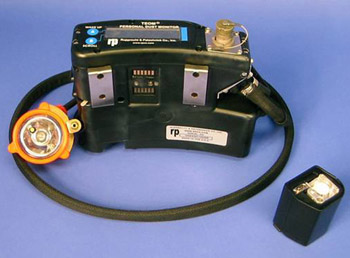 The Mine Safety and Health Administration has proposed that miners wear continuous personal dust monitors like this one. Centers for Disease Control
The Mine Safety and Health Administration has proposed that miners wear continuous personal dust monitors like this one. Centers for Disease Control
At the same time, fear is almost as deeply rooted. Many miners don’t want their employers to know they have signs of black lung—or even that they’ve been X-rayed. Anita Wolfe, who runs NIOSH’s surveillance program and is often out with the RV that screens miners, said she has seen men approaching on foot from miles away because they didn’t want anyone to see their cars parked nearby.
Thanks to a rule MSHA issued in 1980, a miner whose X-ray shows signs of black lung receives a letter that requires his employer to transfer him to a less dusty job and pay him the same as before. The miner alone sees the letter, and he can use it whenever he wants.
Only about 30 percent of the nearly 3,000 letters issued to miners since 1980 have been used, according to MSHA data provided to the Center and NPR.
Sometimes miners avoid screening because they just don’t want to know. A diagnosis of black lung would likely mean having to leave the mines—the best-paying job around and the only way they know to provide for their families. “It’s very known throughout the coal community there’s no cure for this,” Wills said. “They want to pretend like everything’s okay until they just can’t do it anymore.”
All of this has led NIOSH to believe that the resurgence of black lung may actually be worse than its numbers reveal. “We know that there is disease out there that we are not identifying because miners are avoiding participation based upon disease status,” NIOSH epidemiologist Laney said.
Take James Marcum: He spent his last semester of high school taking a class at the University of Kentucky because he already had enough credits to graduate. His father, having filed for black-lung benefits a few years earlier, encouraged him to go to school and stay out of the mines.
Nonetheless, James took a summer job at a mine to earn money for college. “I started earning them $800-a-week paydays and said, ‘Why would I want to go to college when I’m earning this kind of money?'” he recalled, standing in the shadow of Dewey Dam at the family’s annual picnic at Jenny Wiley State Park in Prestonsburg, Kentucky.
He spent about 90 percent of his 20-year mining career, he estimated, operating a continuous miner. In 1991, the motor of the machine he was running caught fire, and smoke overcame him.
When doctors examined him and took X-rays, they found what appeared to be black lung. James kept the news to himself and didn’t file for benefits, afraid he’d lose his job if he did. “It was good money,” he said. “I had my kids to raise, and I just had to work…I never said nothing. I just went on and done my job.”
About six years later, James found himself back in the hospital. He’d been caught between two pieces of the continuous miner and injured his back. Alone in that section of the mine when the accident happened, he finished his shift and went to the hospital the next morning.
Doctors again took X-rays, and, this time, his lungs were so bad he had to see a specialist. A biopsy confirmed that he had black lung.
Since then, breathing has become more and more difficult for him, especially during the past year. “I miss hunting bad,” he said. “I used to take my boys hunting. But I just ain’t able no more…I ain’t got the air to do it.”
The youngest of the three Marcum brothers, he has shown the worst decline in lung function. At the family’s picnic, while Donald socialized and Thomas talked to their father, Ray, over plates of fried chicken, coleslaw, and potato salad, James sat quietly.
He glanced at his oldest son, 26, who now works in a mine. Without realizing it, James paraphrased his father: “I tried to get him out. He won’t come out. He loves the job.”
The Center for Public Integrity is a nonprofit, independent investigative news outlet. This story is part of its Hard Labor series.
